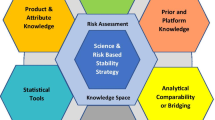Abstract
The global regulatory implementation and acceptance of a science and risk-based stability (SRB) strategies for a stable drug product is reviewed. This stability strategy may also be referred to as “lean stability” since it includes a stability protocol reduction in the number of tests and time points than might normally be applied. A product line extension (new solid dosage form) for a well-understood product was used as a test case for this stability strategy. The drug product line extension was filed globally with a proposed reduction to analytical stability tests and frequency. This stability protocol is aligned with the International Conference on Harmonization of Technical Requirements for Registration of Pharmaceuticals for Human Use (ICH) Q1A (R2) stability guidelines (ICH: Guideline Q1A(R2), 2003), the World Health Organization (WHO) (WHO INT. [Online], 2020), and most country regulatory guidelines. Although this strategy was not accepted universally, the strategy enabled opportunities to engage in productive dialogs with regulatory authorities in several countries on how the case leveraged product understanding and development knowledge to develop a fit for purpose stability protocol. A persistent and consistent effort from industry to move toward product-specific protocols based on product knowledge and stability risk assessments should lead to further acceptance of science and risk-based stability strategies in all regions.
Similar content being viewed by others
References
ICH: Guideline Q1A(R2) (2003). Stability testing of new drug substances and products, Step 4 version. [cited 2020 May 04]. Available from: https://www.ich.org/fileadmin/Public_Web_Site/ICH_Products/Guidelines/Quality/Q9/Step4/Q9_Guideline.pdf.
World Health Organization. WHO INT. [Online]. Geneva; 2018 [cited 2020 May 01. Available from: https://www.who.int/medicines/areas/quality_safety/quality_assurance/TRS1010annex10.pdf?ua=1.
Colgan ST, Watson TJ, Whipple RD, Nosal R, Beaman JV, De Anthonis DM. The application of science- and risk-based concepts to drug substance stability strategies. 2012;7:205–13.
Freed A, Clement E, Timpano R. Regulatory responses to the use of various lean stability strategies in early drug development. Regul Rapp. 2014 August;11(7/8):5–8.
McMahon M, Williams H, Debbie E, Mingkun F, Bujalski R, Qiu F, et al. Utilization of risk-based predictive stability within regulatory submissions; industry’s experience [AAPS Open]. 2020 [cited 2020 May 14. Available from: https://doi.org/10.1186/s41120-020-00034-7.
International Council for Harmonisation of Technical Requirements for Pharmaceuticals for Human Use. ICH Harmonised Guideline. technical and regulatory considerations for pharmaceutical product lifecycle management Q12. Adopted on 20 November 2019;(Final Version).
International Council for Harmonisation of Technical Requirements for Pharmaceuticals for Human Use. In: ICH harmonised tripartite guideline: pharmaceutical development.): Current step 4 version dated November 6, 1996. Stability testing:photostability testing of new drug substances and products Q1B.
International Council for Harmonisation of Technical Requirements for Pharmaceuticals for Human Use. ICH harmonised tripartite guideline annex to the ich harmonised tripartite guideline on stability testing for new drugs and products Q1C. In: Current Step 4 version dated 6; November 1996.
International Council for Harmonisation of Technical Requirements for Pharmaceuticals for Human Use. ICH harmonised guideline. ICH harmonised guideline: bracketing and matrixing designs for stability testing of new drug substances and products Q1D. In: Current Step 4 version dated 7 February 2002.
International Council for Harmonisation of Technical Requirements for Pharmaceuticals for Human Use. ICH harmonised guideline. ICH harmonised tripartite guideline evaluation for stability data Q1E. In: Current step 4 version dated 6 February 2003.
World Health Organization- Technical Report Series N81. Annex 5 _ Guidelines for stability testing of pharmaceutical products containing well established drug substance in conventional dosage forms. Available from: https://www.paho.org/hq/dmdocuments/2008/6_Annex_5_report_34.pdf.
EFPIA. LATAM Network. Latin America stability studies – proposal for harmonization. 2015 May 7.
World Health Organization. Medicines regulations "Comparison of medicines legislation in the east African community. 2016.
WHO/PQT. Request to submit stability data with the submission of documentation for prequalification of finished pharmaceutical products approved by stringent regulatory authorities. 2016.
World Health Organization. Technical Report Series, No. 953 Annex 5_Stability testing of active pharmaceutical ingredients and finished pharmaceutical products. August 24, 2018. [Online]. 2018 [cited 2020 05 01. Available from: https://www.who.int/medicines/areas/quality_safety/quality_assurance/TRS986annex5.pdf?ua=1.
Executive Board of the Health Ministers’ Council for GCC States. The GCC guidelines for stability testing of active pharmaceuticals(APIs) and Finished Pharmaceutical Products (FPPs). 2011.
ASEAN Guideline on Stability Study of Drug Product (R1). [Online]. May 2013 [cited 2020 May 01. Available from: https://asean.org/wp-content/uploads/2018/01/25PPWG-ANNEX-7-iv-Final-ASEAN-Guideline-on-Stability-Study-Drug-Product-R2.pdf.
International Council for Harmonisation of Technical Requirements for Pharmaceuticals for Human Use. ICH Q1 F stability data package for registration applications in climatic zones III and IV. In: June 2006.
Kopp S. Stability testing of pharmaceutical product in a global environment. [Online]. 2006 [cited 2020 May 01. Available from: https://www.who.int/medicines/areas/quality_safety/quality_assurance/RAJ2006WHOStability.pdf?ua=1.
National Medical Products Adminsitration (NMPA). The technical guideline for stability testing of chemical drugs (drug substance and drug products). (Revised) attachment 2. 2015.
Colgan ST, Timpano R, Roberts M, Weaver R, Kevin R, Fields K, et al. Opportunities for lean stability strategies. J Pharm Innov. 2014;9(9):259–71.
Acknowledgments
The authors would like to thank the reviewers, including John Groskoph, Robert Timpano, Timothy Watson, Connie Langer, Chi-wan Chen, Flavia Firmino, Alfonsus Karli, Mike Saleh, and Supriya Bagwe, for reviewing and providing helpful comments on this paper.
Author information
Authors and Affiliations
Corresponding author
Additional information
Publisher’s Note
Springer Nature remains neutral with regard to jurisdictional claims in published maps and institutional affiliations.
Electronic Supplementary Material
ESM 1
(DOCX 66.6 kb)
Rights and permissions
About this article
Cite this article
Diaz, D.A., Lynch, M., McMahon, M. et al. Science and Risked-Based Stability Testing Strategies—a Test Case on the Global Implementation and Regulatory Reception. AAPS J 22, 140 (2020). https://doi.org/10.1208/s12248-020-00515-3
Received:
Accepted:
Published:
DOI: https://doi.org/10.1208/s12248-020-00515-3




